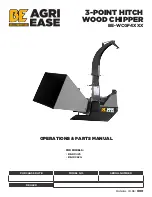
70
IOM 1206-1
Unit Maintenance
Pump the lubricant into the unit through a closed transfer
system. Avoid overcharging the unit.
Use only new sealed metal containers of oil to insure
quality.
Buy smaller containers to prevent waste and
contamination.
Use only filter driers designed for POE and check
pressure drops frequently.
Test for acid and color at least annually. Change filter
driers if acid or high moisture (> 200 ppm) is indicated (<
100 ppm typical).
Evacuate to 500 microns and hold test to insure systems are
dry.
Control and Alarm Settings
The software that controls the operation of the unit is factory-
set for operation with R-410A taking into account that the
pressure/temperature relationship differs from R-22. The
software functionality is the same for either refrigerant.
Refrigerant Charging
The AGZ units have a condenser coil design with
approximately 15% of the coil tubes located in a subcooler
section of the coil to achieve liquid cooling to within 5
°
F (3
°
C)
of the outdoor air temperature when all condenser fans are
operating.
Once the subcooler is filled, extra charge will not lower the
liquid temperature and does not help system capacity or
efficiency.
If a unit is low on refrigerant, you must first determine the
cause before attempting to recharge the unit. Locate and repair
any refrigerant leaks. Soap works well to show bubbles at
medium size leaks but electronic leak detectors are needed to
locate small leaks.
Charging or check valves should always be used on charging
hoses to limit refrigerant loss and prevent frostbite. Ball valve
type recommended.
Charge to 80-85% of normal charge before starting the
compressors.
Charging procedure
The units are factory-charged with R-410A. Use the following
procedure if recharging in the field is necessary:
To prevent fractionalization, liquid must be charged from the
refrigerant cylinder, unless charging the entire cylinder
contents.
The charge can be added at any load condition between 25 to
100 percent load per circuit, but at least two fans per
refrigerant circuit should be operating if possible.
Start the system and observe operation.
Trim the charge to the recommended liquid line sub-cooling
(approximately 14-20 degrees F typical).
Verify the suction superheat (10 degrees F for EEVs and 10 –
12 degrees F for TXVs) at full load conditions.
Use standard charging procedures (liquid only) to top off the
charge.
Check the sight glass to be sure there is no refrigerant flashing.
With outdoor temperatures above 60
°
F (15.6
°
C), all condenser
fans should be operating and the liquid line temperature should
be within 5
°
F to 10
°
F (2.8
°
C to 5.6
°
C) of the outdoor air
temperature. At 25-50% load, the liquid line temperature
should be within 5
°
F (2.8
°
C) of outdoor air temperature with
all fans on. At 75-100% load the liquid line temperature should
be within 10
°
F (5.6
°
C) of outdoor air temperature with all fans
on.
It may be necessary to add refrigerant through the compressor
suction. Because the refrigerant leaving the cylinder must be a
liquid, exercise care to avoid damage to the compressor by
using a flow restrictor. A sight glass can be connected between
the charging hose and the compressor. It can be adjusted to
have liquid leave the cylinder and vapor enter the compressor.
Overcharging of refrigerant will raise the compressor
discharge pressure due to filling of the condenser tubes with
excess refrigerant.
Service
With R-410A, fractionalization, if due to leaks and recharge
has a minimal effect on performance or operation.
Special tools will be required due to higher refrigerant
pressures with R-410A. Oil-less/hp recovery units, hp recovery
cylinders (DOT approved w/525# relief), gauge manifold 30”-
250 psi low/0-800 psi high, hoses w/800 psi working & 4,000
psi burst.
All filter driers and replacement components must be rated
POE oils and for the refrigerant pressure (R-410A 600psig
typical).
R-410A compressor internal relief is 600-650 psid.
Brazed connections only. No StayBrite or solder connections
(solder should never be used with any refrigerant). K or L type
refrigeration tubing only. Use nitrogen purge. Higher R-410A
pressures and smaller molecule size make workmanship more
critical.
R-410A must be charged from cylinder as a liquid unless
entire cylinder is used. Use a Refrigerant flow restrictor if
charging liquid to suction or to a system at pressure below a
saturated temperature of 32° F.
EPA recovery and handling requirements for R-410A are the
same as R-22.









































